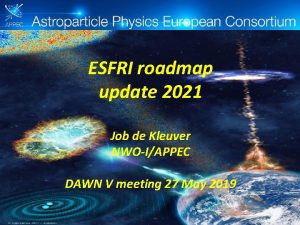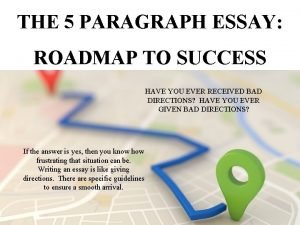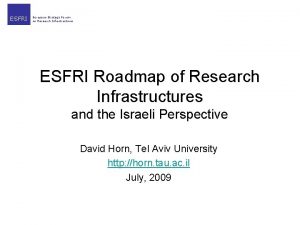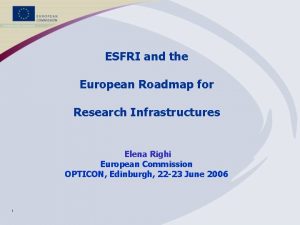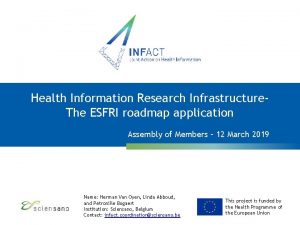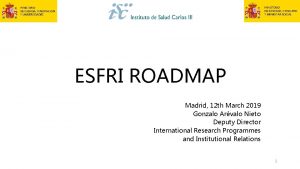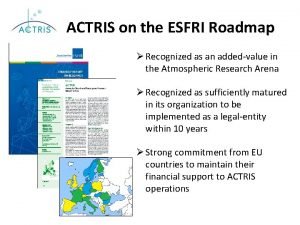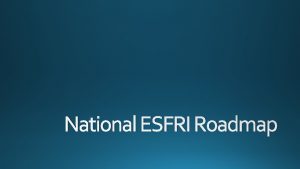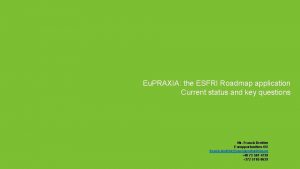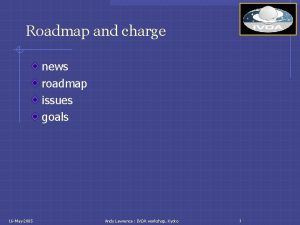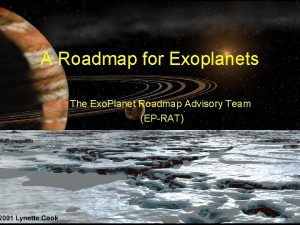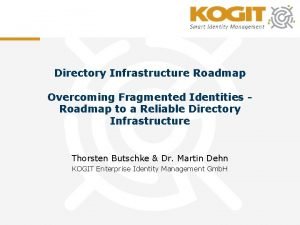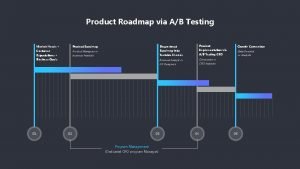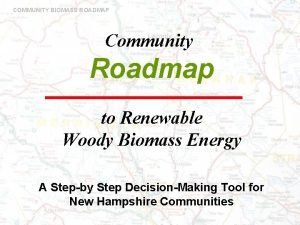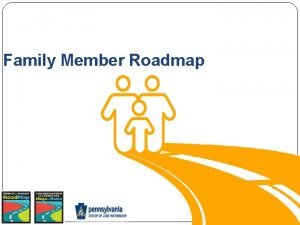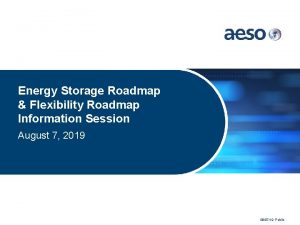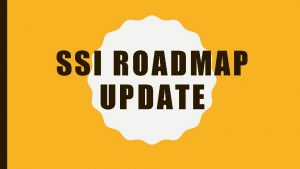ESFRI and the ESFRI Roadmap an introduction Mr































- Slides: 31

ESFRI and the ESFRI Roadmap: an introduction Mr. Franck Brottier Europportunities OÜ franck. brottier@europportunities. ee +40 73 561 4739 +372 5785 0629

Research Infrastructure: Definition “RI are facilities, resources and services that are used by the research communities to conduct research and foster innovation in their fields. They include: major scientific equipment (or sets of instruments), knowledge-based resources such as collections, archives and scientific data, e-infrastructures, such as data and computing systems and communication networks and any other tools that are essential to achieve excellence in research and innovation. ” Article 2 (6) of the Regulation (EU) No 1291/2013 “The term 'Research Infrastructures' refers to facilities, resources or services of a unique nature that have been identified by European research communities to conduct top-level activities in all fields of science. This definition includes the associated human resources, covers major equipment or sets of instruments, in addition to knowledge-containing resources such as collections, archives and data banks. RI may be located in a single site (for example, large telescopes, Synchrotrons, High Performance Computing) or can be distributed across even large number of sites working jointly (for example, biobanks, archives, marine stations). ” Commission Staff Working Document, “Long-term sustainability of Research Infrastructures”, SWD(2017) 323 final, Brussels, September 26 th 2017

ESFRI European Strategic Forum for Research Infrastructures • Mission. support a coherent and strategy-led approach to policy-making on research infrastructures in Europe, and to facilitate multilateral initiatives leading to the better use and development of research infrastructures, at EU and international level • Composition. ESFRI's delegates are nominated by the Research Ministers of the Member and Associate Countries, and include a representative of the Commission • Objective. Overcoming the limits of European research caused by fragmented, national policies and providing Europe with the most up-to-date Research Infrastructures, responding to the rapidly evolving Science frontiers, advancing also the knowledge-based technologies and their extended use. • Tools. ESFRI selects RI projects of pan-European interest on a European roadmap of Research Infrastructures: the ESFRI Roadmap. • ESFRI acts as an advising body to the European Commission on RI matters

ESFRI Roadmap The first ESFRI Roadmap was issued in 2006 • The current Roadmap (Roadmap 2016) includes 21 ESFRI projects and 29 ESFRI landmarks “project” implementation not yet completed (and for the newest projects on the Roadmap, not even started) “landmark” Operational RIs status of “major element of competitiveness of the European Research Area” (and, as such, preserved) • Categories of ESFRI projects: Energy, Environment, Health & Food, Physical sciences & engineering, Social & Cultural Innovation, E-infrastructures • Roadmap is updated every 2 years • RIs on the ESFRI Roadmap are recognized as “facilities, resources or services of a unique nature identified by European research communities to conduct top-level research activities in all fields”. • RIs entering the ESFRI Roadmap should be operational within the next 10 years, or they are taken out of the Roadmap • Maximum 25 projects on the ESFRI Roadmap

What are the advantages of being listed on the ESFRI Roadmap RIs listed on the ESFRI Roadmap benefits from: • Acknowledgment at EU-level of their scientific importance and quality • Support from the European Commission (e. g. INFRADEV calls Preparatory Phases) • Access (or easier access) to Structural Funds for the implementation of the RI

Applying to the ESFRI Roadmap: the Roadmap 2016 example In 2014 -2016, the ESFRI Roadmap selection process was organised in the following manner: Dates Event/Milestone/Deadline September 25 th 2014 ESFRI Roadmap update launch event, organised in Trieste, Italy Comments & Recommendations November 2014 Issuance of the application package, composed of: (see comment) • A 11 -page questionnaire • Guidelines for applicants November 2014 was the due date for issuing the questionnaire. In reality, the questionnaire was only made available later (January 2015). March 31 st 2015 Deadline for the online submission of proposals Only 3 months to prepare the application (2018: 10 months) July 17 th 2015 List of additional questions from ESFRI + Invitation to hearings (see below) After review by the ESFRI Implementation Group and the relevant ESFRI Strategic Work Group September 15 th 2015 Hearings in Brussels: project leaders (+ up to 2 project members) October 2015 Informal final ESFRI Roadmap update selection results communicated to project leaders March 8 -11 th 2016 Official results announced at an ESFRI Roadmap update 2016 event, in Amsterdam, Netherlands

Focus on the questionnaire: question typology What are the questions asked in the ESFRI Roadmap update 2018 questionnaire? The questions asked in the questionnaire address the following aspects of a RI project: # Subject A. General Information ID card of the project B. Key questions Related topics NAME, TYPE, CLASS, TIMELINE, ESTIMATED COSTS, HEADQUARTERS, WEBSITE, BACKGROUND, DESCRIPTION IMPLEMENTATION, POLITICAL SUPPORT A) LEAD COUNTRY/ENTITY B) PROSPECTIVE MEMBER COUNTRIES/ENTITIES C) INCLUSION IN NATIONAL RESEARCH INFRASTRUCTURE ROADMAP (-S) FINANCIAL COMMITMENT A) LEAD COUNTRY/ENTITY B) PROSPECTIVE MEMBER COUNTRIES/ENTITIES C) COVERAGE OF REAL AND ESTIMATED COSTS COORDINATOR PARTICIPANTS SCIENTIFIC DOMAIN All Does the RI project address a scientific challenge(s)/frontier(s) unaddressed or poorly addressed by current infrastructures/facilities? Can this scientific challenge/frontier be associated to one of the societal challenges identified by the European Union? Demand analysis Conceptual Design Study Access policy Stakeholder involvement Scientific case Scientific impact

Focus on the questionnaire: question typology What are the questions asked in the ESFRI Roadmap update 2018 questionnaire? The questions asked in the questionnaire address the following aspects of a RI project: # Subject Key questions Related topics B. Scientific case Pan-European relevance To what extent a European RI is more relevant than other forms of organisation to address the above-mentioned scientific challenge(s)/frontier(s)? To what extent addressing the scientific challenge(s)/frontier(s) at European scale creates added value, compared to addressing it/them at a smaller scale? European RI panorama European Research Area National Roadmaps Socio-economic impact Granted the raison d’être of a RI is to produce excellent science, the contribution to Ris to produce growth and jobs is yet highly appreciated: how will the RI maximise its contribution to this objective? Cost-Benefit Analysis E-needs How will be data collected and produced by the RI be made available to users? Will the new RI seek support from existing e-infrastructures? Open data policy E-infrastructures

Focus on the questionnaire: question typology What are the questions asked in the ESFRI Roadmap update 2018 questionnaire? The questions asked in the questionnaire address the following aspects of a RI project: # Subject Key questions Related topics C. Implementation Stakeholder Commitment How firm are your sponsors? Multi-Lateral Agreement User strategy & Access policy How do you plan to make of your RI the first and obvious choice in the communities relevant for the gap you fill in the ESFRI landscape? On what basis will you grant access to the RI? What is the link between access and sustainability? Preparatory work What is the current level of maturity of the project? Planning What is the implementation schedule for the new RI? Governance and Management How will the new RI be managed and governed? HR policy What are the skills and competencies needed? Do you have them in-house (i. e. among the institutions of the Consortium)? How will you make sure to have those skills and competencies to implement and operate the RI? Finances How will the new RI be financed? Is it sustainable? Does it generate revenues, and, if yes, how and how much? Risks Has a Risk Matrix been defined? What are the main risks identified? How will you mitigate them? Conceptual Design Study Technical Design Report (only for very mature projects, unusual for ESFRI Roadmap candidates) Cost-Benefit Analysis (in particular Sustainability analysis)

Focus on the questionnaire: question typology What are the questions asked in the ESFRI Roadmap update 2018 questionnaire? It is interesting to notice the changes of the ESFRI questionnaire 2018 vs. 2016: • Stakeholder commitment becomes a more prominent subject • Siting less prominent (question category has disappeared) • Socio-economic impact is now part of the Scientific excellence (renamed Scientific case) section

Some tips Documentation required for an ESFRI Roadmap application (based on 2015 experience) Mandatory • Scientific Case Study (White Book) • Conceptual Design Study • Expressions of Commitment (Governments), min. 1 • Expressions of Support (Governments, Funding Agencies), min. 2 • Memorandum of Understanding (Consortium partners) Strongly recommended • Cost-Benefit Analysis • Letters of Support (Peers, i. e. scientific/academic institutions) • Letters of Interest (Industrial users, public/private organisations)

Eu. PRAXIA and the ESFRI Roadmap 2020: some challenges Consider applying to the ESFRI Roadmap 2020? • • • Are you confident that Eu. PRAXIA can be operational by 2030? What is the gap in the European RI landscape that Eu. PRAXIA is filling? Can you justify a critical mass of users? Have you agreed on an access policy? Have you firmed up the implementation and operational costs of such a RI? Have you completed a design/feasibility study? Have you planned a business case/delivery strategy? Can you obtain Expression of political Support (Eo. S) from the lead country? Can you obtain at least two additional Eo. S from Member States and Associated Countries signed by the national ministries responsible for Ris? As a (presumably) single-site RI, can you obtain an Expression of Commitment (Eo. C) from the lead country to financially contribute to the preparation and implementation phases? Will you have a proof of an inter-institutional and multi-lateral agreement, such as a Memorandum of Understanding (Mo. U) signed by the core RI project partners?

ESFRI and the ESFRI Roadmap: an introduction (II) Mr. Franck Brottier Europportunities OÜ franck. brottier@europportunities. ee +40 73 561 4739 +372 5785 0629

Applying to the ESFRI Roadmap: sketch of a process Case in point: What if you apply for the ESFRI Roadmap in 2019? • • How to organise the development of an ESFRI Roadmap application? Is there a recognised or recommended method? Are there minimum requirements to “pass”? Are there things we can do already?

Applying to the ESFRI Roadmap: sketch of a process Task breakdown Tier 1: Identifying all user needs Controls Interactions User needs ESFRI projects and landmarks Stakeholders (including potential users) (Demand Analysis) Tier 2: Defining how to serve users best – the business plan (the “What”) Scientific programme Services & e-services Architecture Access policy Standards & Norms Terms of Services Tier 3: From plan to execution – the business model (the “How”) Legal status Governance & Management Finance Long-term Sustainability Socio-economic impact Risk analysis Research Ministries and Funding agencies Equipment Budget HR Plan Nota: storage the RI project should be apprehended phases of its life-cycle: Data Physical storage in the different Procurement Concept design preparation implementation operation upgrade termination (decommissioning) It is an appropriate exercise to consider each of the above-mentioned dimensions of a RI project in the different phases. e. g. the governance and management of a RI project should certainly evolve between the implementation and the operational phase.

Applying to the ESFRI Roadmap: sketch of a process Defining the “What” (I) Scientific case & Design Study Scientific concept and programm e • • Definition of Services & Activities Funding opportuniti es • Building on the scientific concept and programme… … to define the services and activities of interest for one or more scientific community(ies)… …and develop the scientific case and design study Controls • Benchmarking with existing facilities Interactions • With existing facilities Objective • New service to the scientific/industrial communities targeted • Making sure that there is indeed a gap in the RI landscape

Applying to the ESFRI Roadmap: sketch of a process Defining the “What” (II) Scientific case & Design Study Scientific concept and programm e Demand Analysis Definition of an Access policy • • Definition of Services & Activities Funding opportuniti es Market-sizing: an estimation of the number of potential users Requires long investigations in the communities targeted (scientific, academic, industrial) Controls • Questionnaires/surveys • Conferences/workshops (to communicate and reach out further) Interactions • With research institutions and academia (as potential users) • With industries (as potential users) Objective • Confirming the match between a need identified among potential users and the services/activities contemplated

Applying to the ESFRI Roadmap: sketch of a process Defining the “What” (III) Scientific case & Design Study Scientific concept and programm e Identificati on of relevant technologi es Demand Analysis Definition of Services & Activities Definition of an Access policy • Technolog y options • Funding opportuniti es Being realistic: matching the scientific concept with the technological options In our view, it is possible in an ESFRI application to leave some uncertainties (e. g. which technology? ) as long as there is a credible and detailed plan to come up with a choice by a certain date Controls • Existing plans to come up with a choice Interactions • With industries (as co-developers) Objective • Proving/Establishing a technological edge over alternatives (i. e. existing facilities)

Applying to the ESFRI Roadmap: sketch of a process Defining the “How” (I) Scientific case & Design Study Scientific concept and programm e Identificati on of relevant technologi es • Technolog y options • Socioeconomic impact assessme nt Demand Analysis Definition of Services & Activities Operationa l costs Definition of an Access policy HR Plan Payroll Constructi on requireme nts Constructi on options Funding opportuniti es Estimating the workforce necessary to design, prepare, implement, operate and terminate the RI Infering boundary conditions for the constructions Controls • Human Resource Gap Analysis • Pre-feasibility study Interactions • With design/engineering office Project budget Funding model Objective • Matching ambitions and workforce necessary Negotiatio ns on Eo. C, Eo. S, Lo. I, Lo. S

Applying to the ESFRI Roadmap: sketch of a process Defining the “How” (II) Scientific case & Design Study Socioeconomic impact assessme nt Scientific concept and programm e Identificati on of relevant technologi es Demand Analysis Definition of Services & Activities Operationa l costs Definition of an Access policy HR Plan Payroll Constructi on requireme nts Constructi on options Technolog y options • Maintenan ce costs • Equipment budget estimate Project budget Funding opportuniti es Equipment implement at° plan Estimating the equipment budget and associated maintenance costs Planning the equipment implementation Controls • Planning to develop with industrials Interactions • With industrials (as co-developers and/or as suppliers) Objective • Matching ambitions and equipment Funding model Negotiatio ns on Eo. C, Eo. S, Lo. I, Lo. S

Applying to the ESFRI Roadmap: sketch of a process Defining the “How” (III) Scientific case & Design Study Scientific concept and programm e Identificati on of relevant technologi es Technolog y options Organisati on & Governanc e Demand Analysis Definition of Services & Activities Operationa l costs Legal structure Socioeconomic impact assessme nt Definition of an Access policy HR Plan Constructi on requireme nts Constructi on options • Maintenan ce costs • Payroll Equipment budget estimate Project budget Funding opportuniti es Equipment implement at° plan Funding model Deciding on the most adapted legal form Developing the RI organisation and governance Controls • Benchmark with other RIs Interactions • With legal departments of institutions involved Objective • Adopting the most relevant legal form, organisation, and governance for each of the project life cycle phases Negotiatio ns on Eo. C, Eo. S, Lo. I, Lo. S

Applying to the ESFRI Roadmap: sketch of a process Defining the “How” (IV) Scientific concept and programm e Identificati on of relevant technologi es Organisati on & Governanc e Demand Analysis Definition of Services & Activities Legal structure Definition of an Access policy HR Plan Constructi on requireme nts Constructi on options Scientific case & Design Study Socioeconomic impact assessme nt • Technolog y options Maintenan ce costs Operationa l costs Equipment budget estimate Funding opportuniti es Project budget Equipment implement at° plan • Payroll Constructi on budget estimate Constructi on implement at° plan Funding model Evaluating construction options (making a choice is not mandatory in our view, explaining how and when you take the decision is) Translating into a construction budget Controls • With civil engineers Interactions • With design/engineering office firms Objective • Estimating the implementation budget and maintenance costs Negotiatio ns on Eo. C, Eo. S, Lo. I, Lo. S

Applying to the ESFRI Roadmap: sketch of a process Defining the “How” (V) Scientific case & Design Study Scientific concept and programm e Identificati on of relevant technologi es Technolog y options Maintenan ce costs Organisati on & Governanc e Demand Analysis Definition of Services & Activities Operationa l costs Equipment budget estimate • Funding opportuniti es Legal structure Definition of an Access policy HR Plan Payroll Project budget Equipment implement at° plan Socioeconomic impact assessme nt Constructi on requireme nts Constructi on options Constructi on budget estimate Constructi on implement at° plan Funding model Financial aspects of the RI project: Total implementation budget, operational costs, payroll (for all phases), funding opportunities, funding model completed Controls • Benchmark with other RIs Interactions • With all partners Objective • Measuring the gap to sustainability Negotiatio ns on Eo. C, Eo. S, Lo. I, Lo. S

Applying to the ESFRI Roadmap: sketch of a process Scientific concept and programm e Identificati on of relevant technologi es Organisati on & Governanc e Demand Analysis Scientific case & Design Study Finalising the socio-economic impact assessment Technolog y options Maintenan ce costs Definition of Services & Activities Operationa l costs Equipment budget estimate Legal structure Definition of an Access policy HR Plan Payroll Project budget Equipment implement at° plan Socioeconomic impact assessme nt Constructi on requireme nts Constructi on options Constructi on budget estimate Constructi on implement at° plan Funding model • Funding opportuniti es Evaluation of the RI socio-economic impact Controls • Benchmark with other RIs Interactions • With all partners Objective • Achieving a high socio-economic return • Showing compliance with the Smart Specialisation Strategy and other regional, national or European policies Negotiatio ns on Eo. C, Eo. S, Lo. I, Lo. S

Applying to the ESFRI Roadmap: sketch of a process Fine-tuning & Value engineering Scientific case & Design Study Scientific concept and programm e Identificati on of relevant technologi es Technolog y options Organisati on & Governanc e Demand Analysis Definition ED of S I EV & Services R Activities Operationa l costs Legal structure Definition D of an SE I V E RAccess policy HR Plan ISE Socioeconomic. D E impact VIS E R assessme nt Constructi on requireme nts V D • Maintenan ce costs • D Payroll ISE V Equipment budget estimate Funding opportuniti es Project ED S I budget V E Equipment implement at° plan RE RE R Constructi on options Constructi on budget estimate Constructi on implement at° plan First objective: Insure (on paper…) longterm sustainability of the RI Other objectives: Reduce risks, increase socio-economic impact Not shown on the scheme: • Risk analysis • Match with ESFRI ex-ante indicators • Contribution to address Societal Challenges LE Funding AB N I model TA S SU Negotiatio ns on Eo. C, Eo. S, Lo. I, Lo. S

Applying to the ESFRI Roadmap: sketch of a process Closing discussions on Eo. C, Eo. S, Lo. I, Lo. S Scientific case & Design Study Scientific concept and programm e Identificati on of relevant technologi es Technolog y options Maintenan ce costs Organisati on & Governanc e Demand Analysis Definition ED of S I EV & Services R Activities Operationa l costs Equipment budget estimate Funding opportuniti es Legal structure Definition D of an SE I V E RAccess policy HR Plan ISE Project ED S I budget V E Equipment implement at° plan Socioeconomic. D E impact VIS E R assessme nt Constructi on requireme nts V D D Payroll ISE V RE RE R Constructi on options Constructi on budget estimate Constructi on implement at° plan • • Obtaining min. 1 Eo. C Obtaining min. 2 Eo. S Obtaining as many Lo. I and Lo. S as possible from research institutions and industries Showing links with ETPs, JPIs LE Funding AB N I model TA S SU Negotiatio ns on Eo. C, Eo. S, Lo. I, Lo. S

ESFRI application preparation timeline (indicative)

ESFRI application preparation timeline (indicative)

Focus on key aspects to develop in the context of an ESFRI application Access policy “The definition of an access policy to the global research infrastructure on the basis of peer-reviewed excellence should be agreed upon by the relevant stakeholders from the beginning of the project. ” In our view, the question of access comes second only to the scientific excellence (i. e. the ability of a RI to address better a scientific challenge/domain of importance). Why? Because, if RIs should be compared to businesses, access is what RIs “produce” and “offer on the [scientific] market”. Without a sound “[scientific] offer”, a RI will not produce any “added [scientific] value”. ESFRI promotes RI projects that offer the best value added to scientists, and the access policy should be defined in such a way to maximise the quality of the scientific output. Three types of access: - Excellence-driven Market-driven Wide access The different types can however be mixed. In our view, the “market-driven” access should be limited to 20% for most access to be reserved to scientific excellence (80%). Wide access is a by-word to describe access to data, be it digital or physical (e. g. biological/mineral sample repositories). A sound access policy links access and financial contributions: in our view, it is a mistake to define the access policy independently from or with little consideration for financial sustainability.

Focus on key aspects to develop in the context of an ESFRI application Co-funding of the Implementation Phase by European Structural and Investment Funds (ESIF) “In order to be eligible for ERDF support, RI projects have to contribute to economic, social or territorial cohesion, to sustainable development and structural adjustment of regional economies (Article 2 ERDF Regulation (EU) No 1301/2013). Moreover, they have to contribute to the implementation of the research and innovation strategies for smart specialisation (RIS 3) priorities that were identified in an entrepreneurial discovery process (involving enterprises, research and public sector) and to the implementation of the multiannual plan for budgeting and prioritisation of investments in RIs of the country or region (see Annex 1 to the Common Provisions Regulation for ESI funds (Regulation (EU) No 1303/2013). ” Commission Staff Working Document, “Long-term sustainability of Research Infrastructures”, SWD(2017) 323 final, Brussels, September 26 th 2017

Contact person: Franck Brottier Document: “ESFRI and the ESFRI Roadmap: an introduction (II)” Event: Eu. PRAXIA Collaboration Week, November 24 th 2017 Email: franck. brottier@europportunities. ee Phone number (Estonia): +372 5785 0629 Phone number (Romania): +40 73 561 4739
 Esfri roadmap 2021
Esfri roadmap 2021 Roadmap for essay
Roadmap for essay Hát kết hợp bộ gõ cơ thể
Hát kết hợp bộ gõ cơ thể Ng-html
Ng-html Bổ thể
Bổ thể Tỉ lệ cơ thể trẻ em
Tỉ lệ cơ thể trẻ em Voi kéo gỗ như thế nào
Voi kéo gỗ như thế nào Tư thế worm breton là gì
Tư thế worm breton là gì Chúa yêu trần thế
Chúa yêu trần thế Môn thể thao bắt đầu bằng từ chạy
Môn thể thao bắt đầu bằng từ chạy Thế nào là hệ số cao nhất
Thế nào là hệ số cao nhất Các châu lục và đại dương trên thế giới
Các châu lục và đại dương trên thế giới Công của trọng lực
Công của trọng lực Trời xanh đây là của chúng ta thể thơ
Trời xanh đây là của chúng ta thể thơ Cách giải mật thư tọa độ
Cách giải mật thư tọa độ 101012 bằng
101012 bằng Phản ứng thế ankan
Phản ứng thế ankan Các châu lục và đại dương trên thế giới
Các châu lục và đại dương trên thế giới Thơ thất ngôn tứ tuyệt đường luật
Thơ thất ngôn tứ tuyệt đường luật Quá trình desamine hóa có thể tạo ra
Quá trình desamine hóa có thể tạo ra Một số thể thơ truyền thống
Một số thể thơ truyền thống Cái miệng bé xinh thế chỉ nói điều hay thôi
Cái miệng bé xinh thế chỉ nói điều hay thôi Vẽ hình chiếu vuông góc của vật thể sau
Vẽ hình chiếu vuông góc của vật thể sau Nguyên nhân của sự mỏi cơ sinh 8
Nguyên nhân của sự mỏi cơ sinh 8 đặc điểm cơ thể của người tối cổ
đặc điểm cơ thể của người tối cổ Ví dụ về giọng cùng tên
Ví dụ về giọng cùng tên Vẽ hình chiếu đứng bằng cạnh của vật thể
Vẽ hình chiếu đứng bằng cạnh của vật thể Fecboak
Fecboak Thẻ vin
Thẻ vin đại từ thay thế
đại từ thay thế điện thế nghỉ
điện thế nghỉ Tư thế ngồi viết
Tư thế ngồi viết
